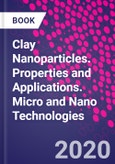Clay Nanoparticles: Properties�and Applications sets out the major properties of clay nanoparticles and their technological applications. The first part of the book focuses on the characterization of nanoclays, including layered, fibrous and tubular clay minerals. The second part illustrates the current and potential applications of nanoclays within material science and biotechnology. These include the development of geopolymers and bionanocomposites based on sustainable polymers filled with ecocompatible nanoclay. The potential use of nanoclays as flame retardants is also discussed, along with the correlation between the properties and potential applications of several nanoclay types.
In particular, the applications explored include nanoclays as drug delivery systems and for environmental protection. The book provides a complete and multidisciplinary exploration of nanoclays, highlighting a range of perspectives within current nanotechnology research.
Please Note: This is an On Demand product, delivery may take up to 11 working days after payment has been received.
Table of Contents
�
Part I Properties of clay nanoparticles
1. Geological overview of clay nanoparticles CRISTINA VILLANOVA-DE-BENAVENT
2. Structural characterization of clay systems by small-angle scattering LEONARDO CHIAPPISI
3. Halloysite nanotubes (HNTs)/polymer nanocomposites: thermal degradation and flame retardancy HENRI VAHABI, RODOLPHE SONNIER, AUR�LIE TAGUET, BELKACEM OTAZAGHINE, MOHAMMAD REZA SAEB AND G�NTER BEYER
4. Colloidal stability and self-assembling behavior of nanoclays LORENZO LISUZZO, GIUSEPPE CAVALLARO, FILIPPO PARISI, SERENA RIELA, STEFANA MILIOTO AND GIUSEPPE LAZZARA
5. Organophilic nature of nanoclay KAUSIK DANA AND MADHUCHHANDA SARKAR
6. Computational modeling of nanoclays EVA SCHOLTZOV�
Part II Technological applications of clay nanoparticles
7. Flame retardant potential of clay nanoparticles AYESHA KAUSAR
8. Nanoclays in drug delivery systems RAQUEL DE MELO BARBOSA, MARIANNA ARA�JO FERREIRA, LYGHIA MARIA ARA�JO MEIRELLES, NICOLE ZORATO AND FERNANDA NERVO RAFFIN
9. Decontamination application of nanoclays HUIJUAN GUAN AND YAFEI ZHAO
10. Clays in cement production from the nanoscale LIDIA NATALIA TRUSILEWICZ
11. Improving the thermal, termite resistance and anti-wetting properties of tropical timber using a polymethyl acrylate/ halloysite coating NISHAL ASHVIN SOLANKI, POORIA PASBAKHSH AND ALI RASHIDI
12. Halloysite nanoclay for development of heterogeneous catalysts SAMAHE SADJADI
13. Covalently modified nanoclays: synthesis, properties and applications MARINA MASSARO, GIUSEPPE CAVALLARO, GIUSEPPE LAZZARA AND SERENA RIELA








